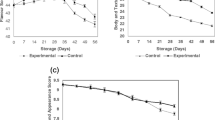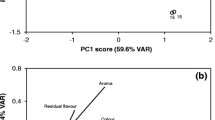Abstract
The intake of sodium in modern western diet is excessive, with potentially harmful effects on health. Consequently, there is a drive to reduce the sodium content of foods. A major source of sodium in processed cheeses (PCs) is the added emulsifying salts (sodium phosphates or citrates) which play a key role in product formation and stabilisation. The present study investigated the impact of reducing the level of disodium orthophosphate (DSP) on the properties of PC. PCs were formulated in triplicate with 0.35, 0.75, 1.29, 2.0, 2.7 or 3.4 g.100 g−1 DSP, and standardised with respect to intact casein content, moisture, protein-to-fat ratio, calcium/casein ratio, and pH. DSP at ≥0.75 g.100 g−1 was necessary to form a homogeneous, stable PC. Increasing DSP significantly increased the storage modulus (G'), firmness and fracture stress of the unheated PC, and reduced the flowability and fluidity (loss tangent max) of the heated PC. These changes coincided with a significant increase in the level of water-soluble protein (WSP) and reduction in the ratio of calcium to WSP in the water-soluble extract prepared using a PC/water at a ratio of 1:2. Our results indicate that there is scope to reduce the sodium level of PCs by reducing the level of added DSP to a minimum level (e.g., ≥0.75 g.100 g−1 in current study), but that reduction from levels (grams per 100 grams) of 2.0–3.4 to 0.75–1.29 markedly alters the textural and cooking properties of the resultant PCs.
磷酸钠对再制干酪物化特性的影响
摘要 现代西方国家饮食中过量钠的摄入对人体健康造成了潜在的危害。因此很有必要减少食品中钠的含量。再制干酪中钠的主要来源是添加的乳化盐(磷酸钠或柠檬酸钠),这些钠盐对再制干酪的成型和稳定起着关键的作用。本文研究了降低磷酸氢二钠添加量对再制干酪特性的影响。再制干酪中磷酸氢二钠的添加量分别为0.35、0.75、1.29、2.0、2.7和3.4 g.100 g−1,分别进行了三个重复,以酪蛋白含量、水分、蛋白与脂肪的比值、钙与酪蛋白的比值以及pH为评价标准。当磷酸氢二钠添加量≥ 0.75 g.100 g−1时才能形成均一和稳定的再制干酪。增加磷酸氢二钠的添加量能够显著地增加未加热再制干酪的储能模量(G')、硬度和破裂应力,但是降低了加热再制干酪的流动性。在制干酪和水比例为1:2时提取的干酪液相中,这些性质的变化与水溶性蛋白含量的显著增加和钙与水溶性蛋白的比值下降相一致。实验结果表明通过减少磷酸氢二钠添加量来达到降低再制干酪中钠的含量是有限定范围的(如本研究的范围是≥ 0.75 g.100 g−1)当磷酸氢二钠含量从2.0∼3.4 g.100 g−1降低到0.75∼1.29 g.100 g−1时,显著地改变了再制干酪的质地和烹饪特性。



Similar content being viewed by others
References
Auty MAE, Twomey M, Guinee TP, Mulvihill DM (2001) Development and application of confocal scanning laser microscopy methods for studying the distribution of fat and protein in selected dairy products. J Dairy Res 68:417–427
Bouchoux A, Cayemitte P-E, Jardin J, Gésan-Guiziou G (2009) Casein micelle dispersions under osmotic stress. Biophys J 96:693–706
Brickley CA, Govindasamy-Lucey S, Jaeggi JJ, Johnson ME, McSweeney PLH, Lucey JA (2008) Influence of emulsifying salts on the textural properties of nonfat process cheese made from direct acid cheese bases. J Dairy Sci 91:39–48
Bryant CM, McClements DJ (1998) Molecular basis of protein functionality with special consideration of cold-set gels derived from heat-denatured whey. Trends Food Sci Technol 9:142–151
Dave RI, McMahon DJ, Broadbent JR (2001) Reversibility of the temperature-dependent opacity of nonfat Mozzarella cheese. J Dairy Sci 84:2364–2371
Evans K (2005) Hyperkalemia: a review. J Intensive Care Med 20:272–290
FAO/WHO (2007) Codex group standard for unripened cheese including fresh cheese. Codex Alimentarius Milk and Milk Products. http://www.codexalimentarius.net/web/standard list. Accessed 12 July 2011
Fenelon MA, Guinee TP (2000) Primary proteolysis and textural changes during ripening in Cheddar cheeses manufactured to different fat contents. Int Dairy J 10:151–158
Fox KK, Harper MK, Holsinger VH, Pallansch MJ (1965) Gelation of milk solids by orthophosphate. J Dairy Sci 48:179–185
Glenn TA, Daubert CR, Farkas BE, Stefanski LA (2003) Statistical analysis of creaming variables impacting process cheese melt quality. J Food Qual 26:299–321
Guinee TP, O’Kennedy BT (2009) The effect of calcium content of Cheddar-style cheese on the biochemical and rheological properties of processed cheese. Dairy Sci Technol 89:317–333
Guinee TP, Feeney EP, Fox PF (2001) Effect of ripening temperature on low moisture Mozzarella cheese. II. Texture and functionality. Lait 81:475–485
Guinee TP, Mulholland EO, Kelly J, O’Callaghan DJ (2007) Effect of protein-to-fat ratio of milk on the composition, manufacturing efficiency, and yield of Cheddar cheese. J Dairy Sci 90:110–123
Guo MR, Kindstedt PS (1995) Age-related changes in the water phase of mozzarella cheese. J Dairy Sci 78:2099–2107
He FJ, McGregor GA (2007) In: Kilcast D, Angus F (eds) Reducing salt in foods practical strategies. Woodhead, Cambridge
Horne DS (1998) Casein interactions: casting light on the black boxes, the structure in dairy products. Int Dairy J 8:171–177
IDF (1982) Milk—determination of total phosphorous content. Spectrometric method. Provisional IDF Standard 42. International Dairy Federation, Brussels
IDF (2007) Milk and milk products—determination of calcium, magnesium, sodium, potassium and magnesium contents—atomic absorption spectrometric method. International Standard ISO 8070 and IDF standard 119. International Dairy Federation, Brussels
Jeurnink TJM, de Kruif KG (1995) Calcium concentration in milk in relation to heat stability and fouling. Neth Milk Dairy J 49:151–165
Kaláb M, Yun J, Yiu SH (1987) Textural properties and microstructure of process cheese food rework. Food Microstruct 6:181–192
Kindstedt PS, Guo MR (1998) A physico-chemical approach to the structure and function of Mozzarella cheese. Aus J Dairy Technol 53:70–73
Kuchroo CN, Fox PF (1982) Soluble nitrogen in Cheddar cheese: comparison of extraction procedures. Milchwissenschaft 37:331–335
Marchesseau S, Cuq JL (1995) Water-holding capacity and characterization of protein interactions in processed cheese. J Dairy Res 62:479–489
Marchesseau S, Gastaldi E, Lagaude A, Cuq J-L (1997) Influence of pH on protein interactions and microstructure of process cheese. J Dairy Sci 80:1483–1489
Mizuno R, Lucey JA (2007) Properties of milk protein gels formed by phosphates. J Dairy Sci 90:4524–4531
Mulder H, Walstra P (1974) The milk fat globule. Commonwealth Agricultural Bureaux, Farnham Royal, Bucks, England, and Centre for Agricultural Publishing and Documentation, Wageningen, the Netherlands
Olson NF, Price WV (1958) A melting test for pasteurized process cheese spreads. J Dairy Sci 41:999–1000
Panouillé MT, Nicolai T, Durand D (2004) Heat induced aggregation and gelation of casein submicelles. Int Dairy J 14:297–303
Park J, Rosenau JR, Peleg M (1984) Comparison of meltability procedures for cheese meltability evaluation. J Food Sci 49:1158–1162
Pastorino AJ, Dave RI, Oberg CJ, McMahon DJ (2002) Temperature effect on structure–opacity relationships of nonfat Mozzarella cheese. J Dairy Sci 85:2106–2113
Rayan AA, Kaláb M, Ernstrom CA (1980) Microstructure and rheology of process cheese. Scanning Electron Microsc III:635–643
Relyveld E (1977) Calcium phosphate gel for absorbing vaccines. United States Patent No. 4,016,252
SAS (2003) SAS® user’s guide: statistics, version 9.1.3. SAS Institute, Cary, NC
Savello PA, Ernstrom CA, Kaláb M (1989) Microstructure and meltability of model process cheese made with Rennet and acid casein. J Dairy Sci 72:1–11
Shirashoji N, Jaeggi JJ, Lucey JA (2006) Effect of trisodium citrate concentration and cooking time on the physicochemical properties of pasteurized process cheese. J Dairy Sci 89:15–28
Shirashoji N, Jaeggi JJ, Lucey JA (2010) Effect of sodium hexametaphosphate concentration and cooking time on the physicochemical properties of pasteurized process cheese. J Dairy Sci 93:2827–2837
Swaisgood HE (2003) In: Fox PF, McSweeney PLH (eds) Advanced dairy chemistry, volume 1: proteins, part A, 3rd edn. Kluwer, New York
Acknowledgments
The authors gratefully acknowledge the technical assistance of Mr. E.O. Mulholland and Ms. C. Mullins and the financial assistance of the Dairy Levy Trust.
Author information
Authors and Affiliations
Corresponding author
About this article
Cite this article
Guinee, T.P., O’Kennedy, B.T. Reducing the level of added disodium phosphate alters the chemical and physical properties of processed cheese. Dairy Sci. & Technol. 92, 469–486 (2012). https://doi.org/10.1007/s13594-011-0053-2
Received:
Revised:
Accepted:
Published:
Issue Date:
DOI: https://doi.org/10.1007/s13594-011-0053-2




